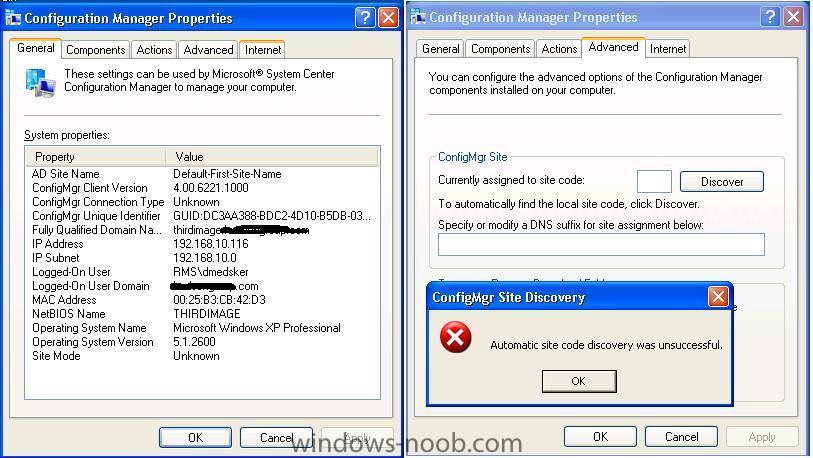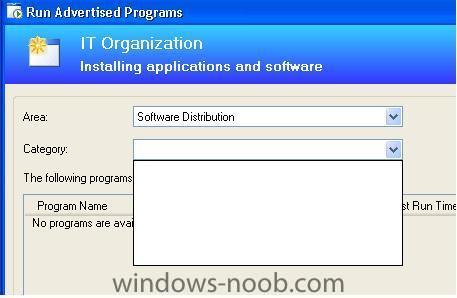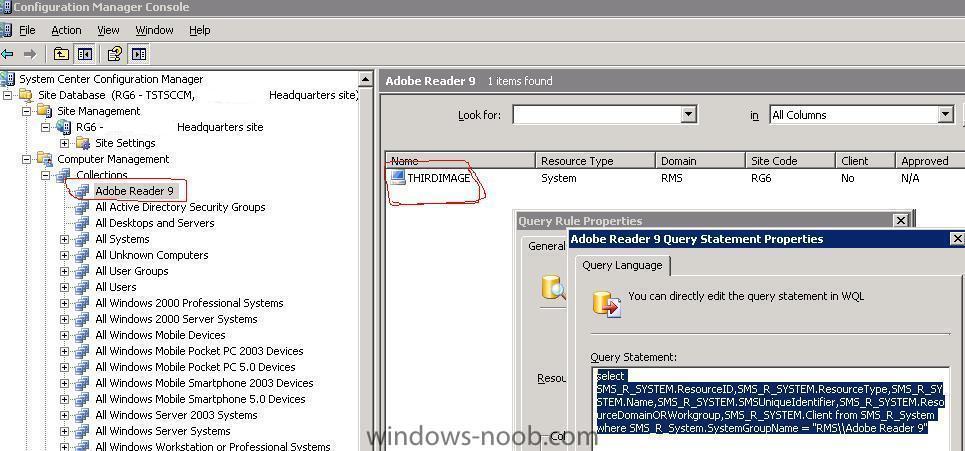
dirtydom
Established Members-
Posts
10 -
Joined
-
Last visited
dirtydom's Achievements
Newbie (1/14)
0
Reputation
-
To inventory software you need to enable the asset intelligence synch point. The settings are desisgnated in client settings afterward. Here's some notes I have about that. Software inventory - set types to designate *.exe or *.dll (examples) - be careful with collect files - this actually collects the files themselves - Set names - artifact from past - shouldn't need to use it.
-
Ok.. Well it appears I managed to get it working without the schema update. I agree the schema update makes things easier and I am expecting more issues until this update is done but I was personally kept from being able to run the update because our Change Control wouldn't allow it. The major only deviation from setting up SCCM is that I disabled updating AD. I did this because of all the errors I got with SCCM trying to update itself in AD and until we extend the schema it's not going to work anyway. This is in the properties of the site. Then what I changed was the command line information for SCCM's client installation. I had to manually specify all the settings so the client knew where it was pointing to. This is a requirement when you have a server locator point instead of an extended schema. This is the syntax I added CCMSETUP.EXE /noservice SMSMP=tstsccm SMSSITECODE=rg6 smslp=TSTSCCM This was in the properties of the program Now I also followed instructions for WSUS config and noticed the client inside the package said yes under WSUS but not under the Adobe pack. I decided to remove the query information all together to make it manually add itself and requery and then this showed the client was "yes". I did that because I had tried reinstalling the client a million times and never once did the actual client say it was "yes". After this the software install and udpates started right up. Thanks again for everybody's help on this!!!
-
No I didn't... do I need to do that in order for the software deployment to work? During my investigation I noticed this; "Four actions need to be taken in order to successfully enable Configuration Manager Clients to query Active Directory Domain Services to locate site resources: Extend the Active Directory schema. Create the System Management container. Set security permissions on the System Management container. Enable Active Directory publishing for the Configuration Manager site." from That appears to be the reason the client can't figure out what site it's in. Is the cause of this issue rooted from this not being done? I speculated that was the case and even mentioned to my boss we probably need to proceed with the more intrusive parts of testing this product. I just hated the idea of trying something out and performing an "irreversible action". I put that in quotes because that's mentioned a lot however that is not the case if you do it carefully it is not irreversible.(rant) anyways thanks for the reply... I'll look forward to another one!
-
Disclaimer… while writing this post I noticed a lot of errors all over the place under system status. These issues I encountered were encountered yesterday without all of these errors occurring. I will start looking into the errors however from first glance they appear to be WSUS related which is not what I’m writing about here. I did notice a management point error explaining it’s not responding to HTTP requests (I just installed the Reporting Point yesterday so there might be a conflict between the two items using port 80?). Anyways I still felt while I look at these errors my post should still be reviewed because It is probably separate. This is my second post... First I want to add to the appreciation of this forum. The information and step by step guids have proven invaluable and I really appreciate it! What I am trying to figure out is why my test machine isn't responding to advertisements... I am trying to figure this out because obviously the software isn't installing from the pack. Here's what I have configured... I followed your instructions to configure SCCM however I did it on a windows 2003 server instead of 2008. It is a virtual Server running on VMWare ESXI. The only thing I have not done is extend the schema for SCCM or manually do anything with AD like ADSI edit. I didn't do that because this is a test environment and I did not want to intrude on AD. If that's all I have to do to resolve this issue please tell me. I have successfully setup deployment of Windows XP for multiple versions of hardware which include software and driver installation specific to the hardware. This software package I created is the first package so far. It is adobe reader 9. I set the package up by creating a transform file through Adobe's Customization Wizard 9. Here is the command line which works if I run it manually from a computer... *(I mean from the command line I can run this command but obviously because it is remotely and manual I have to designate the full network paths of the files) msiexec.exe /i AcroRead.msi TRANSFORMS=AcroRead.mst /qb What I am noticing is that the PC’s Configuration manager does not know what SCCM site it is in. I am also not seeing any advertised software from the “Run Advertised Programs” I am also getting a lot of warnings on the client when I try to run the “repair” from the configuration manager. Event Type: Warning Event Source: WinMgmt Event Category: None Event ID: 63 Date: 11/16/2009 Time: 4:47:30 PM User: NT AUTHORITY\SYSTEM Computer: THIRDIMAGE Description: A provider, PolicyAgentInstanceProvider, has been registered in the WMI namespace, root\ccm\Policy\S_1_5_21_1504005034_1371222036_1539857752_8570, to use the LocalSystem account. This account is privileged and the provider may cause a security violation if it does not correctly impersonate user requests. Event Type: Warning Event Source: WinMgmt Event Category: None Event ID: 63 Date: 11/16/2009 Time: 4:47:30 PM User: NT AUTHORITY\SYSTEM Computer: THIRDIMAGE Description: A provider, PolicyAgentInstanceProvider, has been registered in the WMI namespace, root\ccm\Policy\Machine, to use the LocalSystem account. This account is privileged and the provider may cause a security violation if it does not correctly impersonate user requests. Event Type: Warning Event Source: WinMgmt Event Category: None Event ID: 63 Date: 11/16/2009 Time: 4:47:30 PM User: NT AUTHORITY\SYSTEM Computer: THIRDIMAGE Description: A provider, AMTInvProvider, has been registered in the WMI namespace, root\cimv2\SMS, to use the LocalSystem account. This account is privileged and the provider may cause a security violation if it does not correctly impersonate user requests. Event Type: Warning Event Source: WinMgmt Event Category: None Event ID: 63 Date: 11/16/2009 Time: 4:47:29 PM User: NT AUTHORITY\SYSTEM Computer: THIRDIMAGE Description: A provider, AMTProvisionProvider, has been registered in the WMI namespace, root\CCM, to use the LocalSystem account. This account is privileged and the provider may cause a security violation if it does not correctly impersonate user requests. Event Type: Warning Event Source: WinMgmt Event Category: None Event ID: 5603 Date: 11/16/2009 Time: 4:47:29 PM User: NT AUTHORITY\SYSTEM Computer: THIRDIMAGE Description: A provider, BcdProv, has been registered in the WMI namespace, root\wmi, but did not specify the HostingModel property. This provider will be run using the LocalSystem account. This account is privileged and the provider may cause a security violation if it does not correctly impersonate user requests. Ensure that provider has been reviewed for security behavior and update the HostingModel property of the provider registration to an account with the least privileges possible for the required functionality. Event Type: Warning Event Source: WinMgmt Event Category: None Event ID: 63 Date: 11/16/2009 Time: 4:47:27 PM User: NT AUTHORITY\SYSTEM Computer: THIRDIMAGE Description: A provider, AAInstProv, has been registered in the WMI namespace, root\cimv2\sms, to use the LocalSystem account. This account is privileged and the provider may cause a security violation if it does not correctly impersonate user requests. Now from the server side what I did was create a collection with this query to designate the security group I created for this package named adobe reader 9. select SMS_R_SYSTEM.ResourceID,SMS_R_SYSTEM.ResourceType,SMS_R_SYSTEM.Name,SMS_R_SYSTEM.SMSUniqueIdentifier,SMS_R_SYSTEM.ResourceDomainORWorkgroup,SMS_R_SYSTEM.Client from SMS_R_System where SMS_R_System.SystemGroupName = "RMS\\Adobe Reader 9" This is what I am seeing with regard to the Advertisement status for this package. When I look at a report of the active advertisements I see this Report Name: Status of a specific advertisement Category: Software Distribution - Advertisement Status Comment: This report shows the status summary of all resources that have been targeted by an advertisement. The summary is broken into two parts. Acceptance status will summarize how many resources have received, rejected, or not yet received the advertisement. Delivery status will summarize the resources that have run or attempted to run the program being advertised. Parameters: Advertisement ID RG62000B Status of a specific advertisement 11/17/2009 9:31:34 AM (Number of Records: 0) No matching records could be found. 11/17/2009 9:31:34 AM (Number of Records: 0) Any ideas for which direction to take? I am sure I am missing something, sometimes all it takes is another set of eyes. This is the work I did all day yesterday so I figured I would stop wasting time and finally ask for help. Thank you!
-
how can I target applications to specific hardware
dirtydom replied to anyweb's question in Deploy software, applications and drivers
This method worked... I don't know if it is best practice or not. it seems like it's AOK. -
how can I target applications to specific hardware
dirtydom replied to anyweb's question in Deploy software, applications and drivers
A few questions about this process. About adding packages for drivers... 1. Can I add multiple programs by simply adding multiple programs to the Sequence? What I mean is... I added a software package for a single device... In this case an HP NC2400. I then proceeded to add a quiclaunch driver setup.exe program and then a chipset.exe. I then designated the same package twice under the folder I created for the NC2400 and just designating the two programs seperately. If yes then... 2. When I setup the package I am designating source files but then I am unsure as to how that fits with multiple programs. In this attempt I simply designated a folder \\seervername\drivers$\nc2400 which contained both the folders for the quicklaunch and the chipset and that didn't give me any trouble. About adding driver packages instead of software packages. 1. I am only creating a software package because I have an MSI or EXE to install instead of an INF right? If I have an INF I create a driver package instead. I think I already saw that somewhere yesterday but I wanted to make sure. Thank you,











